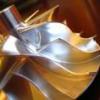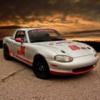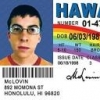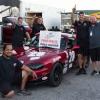Hey Guys,
I've been using my 91 Miata for HPDE's for the last couple years (I'm in Group 3 or 4 depending on the track) with plans on going to SM eventually.
I have rebuilt the stock brake system on the car using reman'd front calipers and stock rear calipers with the carbotech XP10/XP8 pad combo. I also added front brake ducts to the car using trackspeed engineering backing plates before the last track weekend.
As I've gotten faster, I've noticed that the seals on the reman front calipers (el-cheapo Advance Auto Parts "Fenco" brand with a lifetime warranty) have tended to crack/deform from the heat of track use. This has led me to have to replace the calipers with replacement reman'd units after the last two track weekends. It doesn't sound like this is a normal thing for the SM community, but I could be wrong. I'm wondering if the seals in these reman's are just low quality...I'm considering exchanging for another pair of remans (so that they're cleaned up) and then rebuilding them with better seals.
I'm sure that I can improve my braking and compress my brake zones more, which can help with putting less heat into the system, but I don't think I'm really long on the pedal. All my instructors have been pleased with my braking technique (although none of them have been SM drivers....).
Also, I've heard of having to re-lube the caliper bolts after each track day to make sure that the caliper slides properly. I know mine need it after a weekend because the slide-bolts become pretty gummed up (I'm using Permatex Ultra Disc Brake Caliper Lube). This isn't a huge deal to do, but I'm wondering if there's anything better out there.
So my questions are:
1) How long do your caliper seals last you and what brand are you using?
(Do OEM Mazda seals or another brand of rebuild kit seals hold up better? I see that the guys at AdvancedAutosports sell the Raybestos ones...)
2) Is there a better higher-temp caliper lube that you guys use?
Thanks!
-Mike




 Sign In
Sign In Create Account
Create Account





 Back to top
Back to top Report
Report













